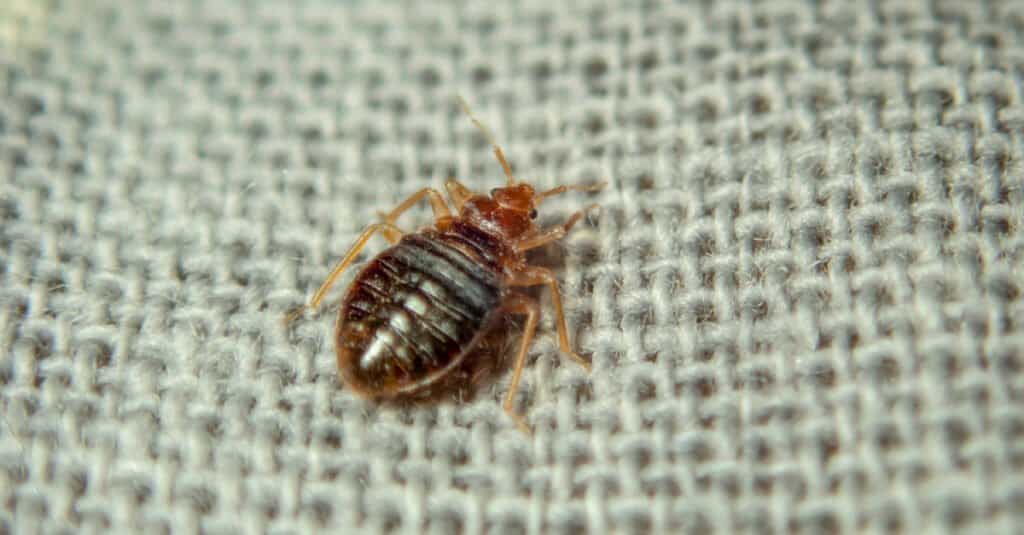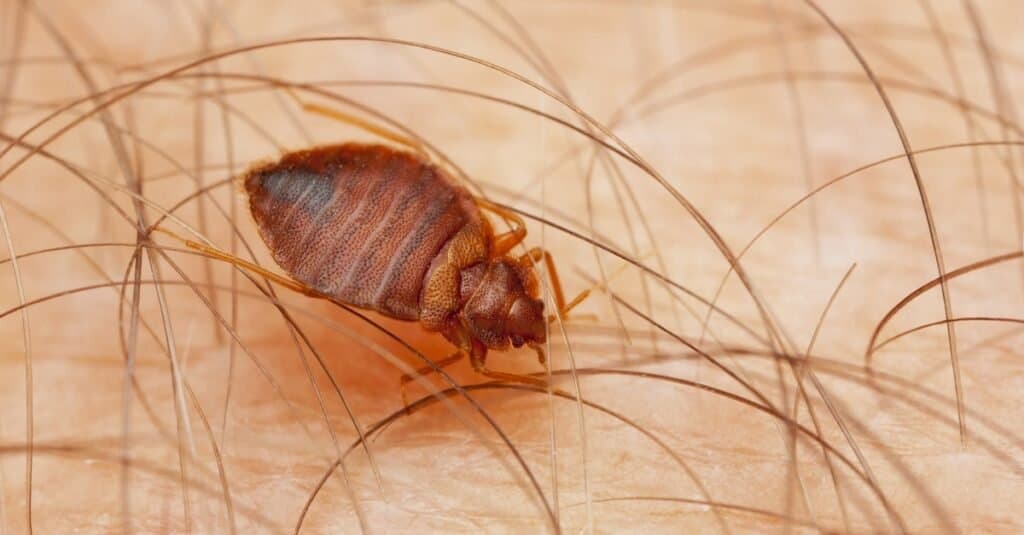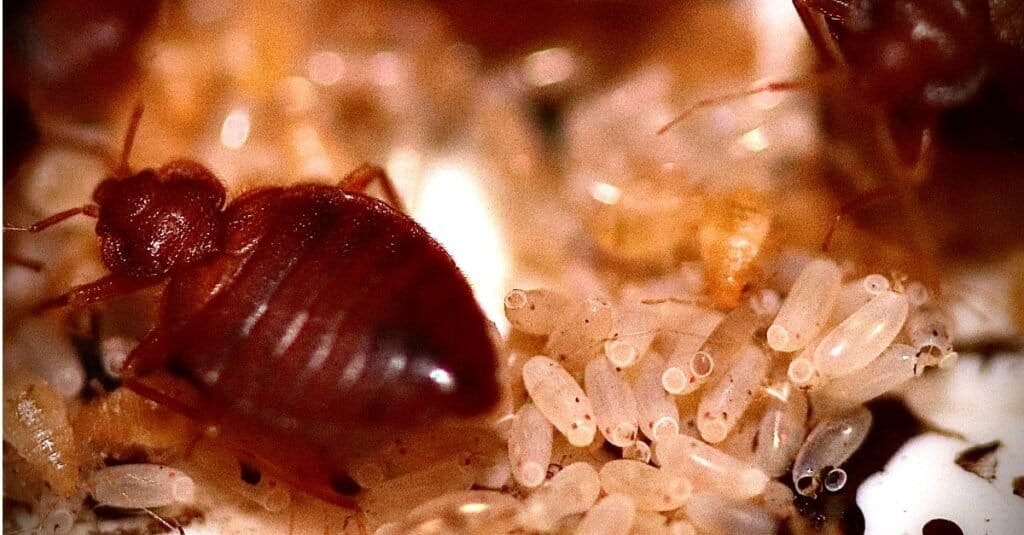Bed bugs may seem like teeny tiny insects, almost invisible to the naked eye. On top of that, these pests often attack at night when the host is asleep, making them even harder to identify. Males are unable to lay eggs; only females can. So it’s critical to recognize the difference as it allows you to determine whether lone bed bugs have been reproducing in your house. Below, we’ll show you how to tell a male bed bug completely from a female one.
Comparing a Male and Female Bed Bug
| Male Bed Bug | Female Bed Bug | |
|---|---|---|
| Shape | Pointed | Rounded |
| Fertility | Can’t lay eggs | Lays eggs |
Key Differences Between Male and Female Bed Bugs

Males and female bed bugs have nearly identical appearances, making it impossible to distinguish between them at first glance.
©Dmitry Bezrukov/Shutterstock.com
Male and female bed bugs are hard to distinguish because, apart from their diminutive size, males and females of the species have very few differences. There are only two ways to determine whether the bed bug you are looking at is a male or female: the shape of their abdomen and whether or not they lay eggs.
It’s seldom simple to distinguish between male and female insects, and most of the time, it’s not critical, but not when it comes to bed bugs. A male or a pregnant female bed bug being discovered in your bedroom can let you know if you have an infestation in your home. Males and females have nearly identical appearances, making it impossible to distinguish between them at first glance. But since a growing infestation can be challenging to eradicate, it’s critical to understand how to spot bed bugs, so you don’t confuse them for other bugs. Below, we will discuss the two main differences between male and female bed bugs.
Male vs. Female Bed Bug: Shape

Bed bugs are typically brownish-red in color.
©Pavel Krasensky/Shutterstock.com
The easiest way to differentiate male from female bed bugs is the shape of their abdomen. Males have a pointed abdomen, more like a V-shape, whereas females have a rounder one, resembling the letter U.
Both male and female bed bugs are typically brownish-red in hue. The size of adult bed bugs is comparable to an apple seed. Because of how the male abdomen is shaped, they are significantly longer. After a blood meal, they will widen and increase in length to take in more blood. Both bed bugs’ abdomens extend horizontally and vertically when drinking blood.
Male vs. Female Bed Bug: Fertility

Female bed bugs lay 200 to 250 eggs in their lifetime.
©iStock.com/Matteo Lanciano
Although both male and female bed bugs bite, females are considered a worse nuisance because they are the only ones that lay eggs and spread infestations. A single female can lay 200 to 250 eggs in her lifetime. On the other hand, male bed bugs cannot lay eggs, and due to the absence of ovaries, they cannot create them.
Can Female Bed Bugs Lay Eggs On Their Own?
Bed bugs have separate male and female reproductive systems because they are gonochoristic, which means they have two unique sexes. Therefore, for a female to procreate, a man must fertilize her.
Bed bugs, though, are unique in one way. After mating, the female can keep the male’s sperm for a very long time and draw on it repeatedly to produce multiple eggs instead of just one.
What Do Bed Bug Eggs Look Like?
Bed bug babies, commonly referred to as nymphs, can be quite challenging to identify. In contrast to the darker brown color of adults, babies are smaller than a pinhead and seem white or tan. Babies go through five growth phases, replacing their exoskeleton with a larger one and eating a lot of blood to gain weight. These babies may not be visible to you, but their shed skins can be a reliable means of identification.
Bed bugs are frequently mistaken for other species because of their resemblance in size, color, and form and their comparable bite symptoms. While ticks, fleas, mites, and lice have slight similarities, they each have different preventative and treatment strategies. These insects may even be confused with young spider beetles and cockroaches.
Male vs. Female Bed Bug: Which is Worse?
It is irrelevant to distinguish the males from the females if you have an already huge infestation. However, if you only discovered one bed bug, that could be a minor or major issue. Whether the bug is a male or a female will determine this. The bug may have been laying eggs nearby if it is a female. However, it is still worth noting that either sex is as bad as the other, as both are necessary for the species’ survival and reproduction.
Do Both Male and Female Bed Bugs Bite?
Both male and female bed bugs will bite and feed when hungry since they need blood to survive and procreate. They all have mouths quite different from ours. The proboscis, which they utilize to sip, is the main component of their mouth. Once they reach adulthood, both will feed continuously for the duration of their lives.
Up Next:
Can Bed Bugs Live In Your Hair?
Bed Bugs Treatment: 7 Ways to Deal with a Bed Bug Infestation
The photo featured at the top of this post is ©
Sources
- Bed Bugs Insider, Available here: https://www.bedbugsinsider.com/male-vs-female-bed-bug/
- Pest Stop Solutions, Available here: https://www.peststopsolutions.com/male-and-female-bed-bugs-difference/
- Terminix, Available here: https://www.terminix.com/blog/education/male-vs-female-bed-bugs/
Thank you for reading! Have some feedback for us? Contact the AZ Animals editorial team.






